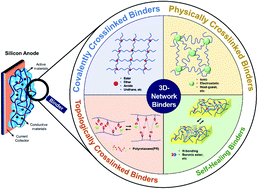Progress of 3D network binders in silicon anodes for lithium ion batteries
Abstract
Prompted by its overwhelming benefits, silicon (Si) has evolved as one of the most promising anode materials for high-capacity lithium-ion batteries (LIBs). However, some of the intrinsic drawbacks such as low ionic conductivity and inevitable volume change during the alloying/dealloying process seriously hamper the commercialization of Si-based anodes in LIBs. Among the several strategies to overcome the challenges of the Si anode, the development of designed polymeric binders is imperative for enabling stable and satisfactory performance. The improved cell performance due to the designed binders is recognized as an economical and practical approach, especially from the industrial perspective. In addition to their conventional role in integrating electrode components, binders also play a significant role in alleviating the unfavorable phenomenon of volume expansion, and ultimately stabilizing the Si anode and Si-electrolyte interphase. The polymer architecture of the binders significantly influences the binder performance, and three-dimensional (3D) network binders are generally more effective at coping with the stress resulting from the huge volume change of the Si anode. To develop advanced 3D binders, substantial research efforts have been made including various crosslinking strategies in the past decade. In this review, we focus on diverse crosslinking methods including chemical-, physical-, and topological-crosslinking for rationally designing network binders for Si anodes and take a glance at dynamic interactions to construct healable binders for long-term stability.

- This article is part of the themed collection: Journal of Materials Chemistry A Recent Review Articles


 Please wait while we load your content...
Please wait while we load your content...
